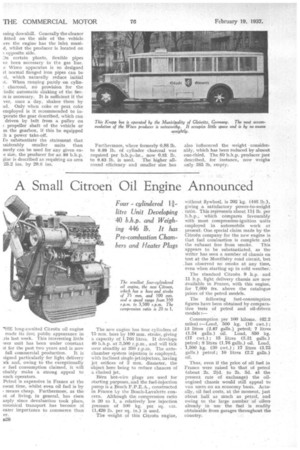A Small Citroen Oil Engine Announced
Page 46

If you've noticed an error in this article please click here to report it so we can fix it.
Four cylindered 1litre Unit Developing 40 b.h.p. and Weighing 446 lb. It has Pre-combustion Charn hers and Heater Plugs
HE long-awaited Citroen oil engine made its first public appearance in .ris last week. This interesting little wer unit has been under constant it for the past two years and is no-w full commercial production. It is signed particularly for light delivery iric and, owing to the exceptionally 01 fuel consumption claimed, it will obably make a strong appeal to each operators.
Petrol is expensive in France at the esent time, whilst even oil fuel is by means cheap. Furthermore, as the st of living, in general, has risen arply since devaluation took place, onomical transport has become of eater importance to commerce than or.
B28
The new engine has lour cylinders of 75 mm. bore by 100 ram. stroke, giving capacity of 1.766 litres. It develops 40 b.h.p. at 3,4500 r.p.m., and will tick Over steadily at 350 r.p.m. The antechamber system injection is employed, with inclined single-jet injectors, having jet orifices of 2 mm. diameter, the object here being to reduce chances of a choked jet.
Bern hot-wire plugs are used for starting purposes, and the fuel-injection pump is a Bosch F.P.E.A., constructed in France by the Bosch-La.valette concern. Although the compression ratio is 20 to 1, a relatively low injection pressure of 100 kg. per sq. cm. (1,420 lb. per sq. in.) is used.
The weight of this Citroen engine,
without flywheel, is 202 kg. (446.1b.),, giving .a satisfactory power-to-weight ratio. This represents about 114 lb. per ti.h.p., which compares favourably with most compression,ignitiOn .units employed in automobile work at present. One special claim made by the Citroen company for the new engine is that fuel combustion is complete and the exhaust free from smoke. This appears to be substantiated, as the writer has seen a number of chassis on test at the Montlhery road circuit, but . has observed no smoke at any time, even when starting up in cold weather, The standard Citroen 9 h.p. and 11 h.p. light delivery chassis are now Available in France, with this engine, for 7,000 frs. above the catalogue prices of the petrol models.
The following fuel-consumption figures have been obtained by comparative tests of petrol and oil-driven models:— Consumption per 100 kilorns. (62.2 miles) :—Load, 500 kg. (10 cwt.) ; 13 litres (2.87 galls.) petrol; 7 litres (1.54 galls.) oil. Load, 850 kg. (17 cwt.) ; 15 litres (3.31 galls.) petrol ; 8 litres (1.76 galls.) oil. Load, 1,500 kg. (30 cwt.) ; 17 litres (3.75 galls.) petrol; 10 litres (2.2 galls.)
Thus, even if the price of oil fuel in France were raised to that of petrol (about 2s. 23:d. to 2s. 3d. at the present rate of exchange) the oilengined chassis would still appeal to van users on an economy basis. Actually, oil fuel costs, at the moment, just about half as much as petrol, and owing to the large number of oilers already in use the fuel is readily obtainable from garages throughout the country.




















































































